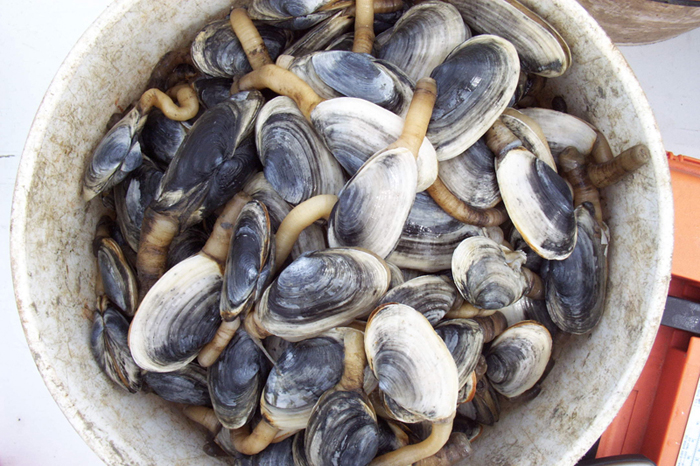Brief History of the Softshell Clam Fishery
in the Chesapeake Bay
 The hydraulic escalator dredge was developed and first used to harvest subtidal softshell clams in Maryland in 1951. Landings were initially modest as markets were developed and entries into the fishery expanded. By 1955 the fishery was well developed and through 1971, annual harvests of softshell clams averaged about 460,000 bushels (370-460 million clams per year). The effect of a series of fishery regulatory restrictions (1952-1958) is not documented, but conversations with several clammers who were active during the first two decades of the fishery indicated that without these restrictions, harvest totals could have been 3-4 times greater. Nevertheless, it is apparent that softshell clam populations were substantial and widespread, particularly from the Potomac River north to the Upper Bay. In hindsight, several events foreshadowed later catastrophes. In 1954 a parasite, Perkinsus sp.(later P. chesapeaki), was reported to be infecting softshell clams in Virginia; in 1965, a major mortality event occurred in the Potomac drainage, essentially ending commercial harvesting in that area; in 1968, the Virginia fishery (albeit modest with respect to Maryland's) collapsed; and in 1971 widespread mortalities occurred in Maryland, coincident, although not necessarily correlated with, the report of an unknown hyperplasia found in the gill tissue of softshell clams in Maryland. It is widely assumed that Tropical Storm Agnes in 1972 caused the subsequent, severe declines in softshell clam landings, and inability of populations to return to pre-1972 levels. The report in 1971 of an unknown hyperplasia, combined with what we now know about DN disease and its devastating effects on clam populations, does suggest an alternative or companion causal factor to TS Agnes effects.
The hydraulic escalator dredge was developed and first used to harvest subtidal softshell clams in Maryland in 1951. Landings were initially modest as markets were developed and entries into the fishery expanded. By 1955 the fishery was well developed and through 1971, annual harvests of softshell clams averaged about 460,000 bushels (370-460 million clams per year). The effect of a series of fishery regulatory restrictions (1952-1958) is not documented, but conversations with several clammers who were active during the first two decades of the fishery indicated that without these restrictions, harvest totals could have been 3-4 times greater. Nevertheless, it is apparent that softshell clam populations were substantial and widespread, particularly from the Potomac River north to the Upper Bay. In hindsight, several events foreshadowed later catastrophes. In 1954 a parasite, Perkinsus sp.(later P. chesapeaki), was reported to be infecting softshell clams in Virginia; in 1965, a major mortality event occurred in the Potomac drainage, essentially ending commercial harvesting in that area; in 1968, the Virginia fishery (albeit modest with respect to Maryland's) collapsed; and in 1971 widespread mortalities occurred in Maryland, coincident, although not necessarily correlated with, the report of an unknown hyperplasia found in the gill tissue of softshell clams in Maryland. It is widely assumed that Tropical Storm Agnes in 1972 caused the subsequent, severe declines in softshell clam landings, and inability of populations to return to pre-1972 levels. The report in 1971 of an unknown hyperplasia, combined with what we now know about DN disease and its devastating effects on clam populations, does suggest an alternative or companion causal factor to TS Agnes effects.
Numerous factors shaped the post-1972 fishery, softshell clam stock size, and geographic and habitat distribution. These include the reduction of the daily limit from 40 to 25 to 15 bushels, external market forces (most softshell clams caught in Maryland are sold in New England), the so-called Bruce Decision (1971) that rescinded the restriction on watermen from fishing waters outside their county of residence, the establishment of the razor clam fishery in the early 1980's in response to the need for an alternative blue crab bait, and diseases eroding population levels.
After TS Agnes, the fishery averaged about 165,000 bushels per year from 1974 through 1983, as compared with the 1955-1971 average of 460,000 bushels per year. Interestingly, this decrease corresponds almost exactly with the reduction in the daily limit from 40 to 15 bushels per day. To attribute this differential solely to the daily limit change, however, is not possible nor would it be credible given the number and variety of events that transpired post-TS Agnes.
In 1984, DN disease was documented in Maryland softshell clam populations, coincident with a sharp decline in landings. Harvests picked up briefly from 1987 through 1991, averaging 260,000 bushels per year. In 1990, Perkinsus chesapeaki infections were found in Maryland populations; harvests crashed in 1992 and since then have averaged less than 17,000 bushels per year and less than 4,000 bushels per year over the last decade.
The current softshell clam fishery in the Chesapeake Bay can be classified as remnant. Few in the clam industry target this species with landings now measured in the hundreds of bushels.
 MD Clam Harvest & Values 1951-2010
MD Clam Harvest & Values 1951-2010
Mya Life History